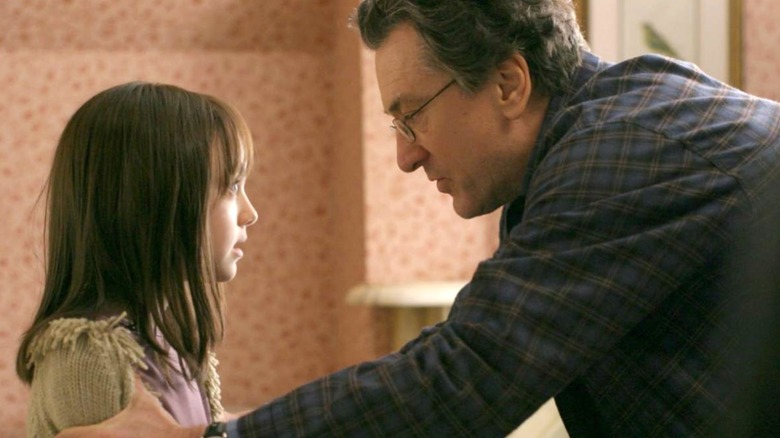A Robert De Niro Horror Movie Had A Dizzying Amount Of Endings
When John Polson's "Hide and Seek" hit theaters in 2005, it grossed close to $122 million worldwide against a $25 million production budget. As you can tell, this psychological horror flick did pretty well at the box office, but it failed to impress critics, who dismissed it as silly and formulaic at the time. These criticisms aren't entirely unfounded, as the film springs a few undercooked twists at you to rush towards the ending, negating any catharsis that is promised during its one and a half hour run. That said, "Hide and Seek" feels more substantial than it is because of two convincing performances — namely, Robert De Niro and Dakota Fanning, who play a severely traumatized father-daughter duo in this tale about trauma.
The premise is rather simple. Psychologist David Callaway (De Niro) decides to move states after his wife's apparent suicide, primarily because his 9-year-old daughter Emily (Fanning) needs a better support system. While this move is well-intentioned, Emily starts talking to her imaginary friend "Charlie" right around this time, causing David to worry about her mental state after a string of unsettling events occur.
As time progresses, we witness Emily undergo a troubling transformation. Gone is the sweet innocence of the child who used to dote on her father, as Emily becomes more violent and vindictive while exhibiting disdain toward David. This exploration of trauma through a seemingly supernatural lens grants "Hide and Seek" the fuel needed to stick its landing, but the film regrettably takes a cliched route to deliver a twist ending that is shocking for the sake of it. Right before the twist is delivered, we learn that David was Charlie all along, as the latter is a manifestation of a more murderous alter-ego who has killed several people, including his wife.
Even before the implications of David being Charlie set in, "Hide and Seek" throws in a final twist: Emily develops Dissociative Identity Disorder (DID) due to the trauma of the events. This reveal is rather sudden, conveyed through one of her drawings that portrays her with two heads instead of one. Crude thematic handling aside, the film actually has four alternate endings that double down on this sentiment in one way or another. Let's take a look at these alternate endings.
Save for one, every Hide and Seek ending is extremely feel-bad
Multiple endings are a way of experimenting with varying story outcomes, but this approach only works when the film has something substantial to say. A prominent example of an impactful, yet divisive alternate ending in horror is 2005's "The Descent," where its international cut offers a more hopeless (and fittingly visceral) conclusion than its U.S. counterpart. This is not the case with "Hide and Seek," as its widely-watched U.S. theatrical cut (the one that hints at Emily's DID through a self-portrait) isn't convincing enough in the first place, given how shoddily it handles the theme of mental illness.
I must add that there's nothing wrong with portraying trauma-fueled mental illness as curses that linger, especially when it's explored with empathy and nuance (examples being "Smile" and its follow-up, "Smile 2," which portray the complexity of trauma to bone-chilling effect). However, "Hide and Seek" reduces this requisite nuance to shock value, and all of the other endings reflect this bungled approach. For instance, there's the "One Final Game" ending, where Emily is seen inside an apartment with her guardian, Katherine, who speaks to her gently and quietly shuts the door from the outside. The moment we cut to Katherine's perspective, it is revealed that Emily is actually inside a psychiatric ward for children. When we cut back to Emily, she counts down for a game of hide-and-seek and smiles at her own reflection. While this seems like a continuation of the U.S. cut, there's something grossly heavy-handed about this bleak conclusion that doesn't do the film any favors.
There's also an international theatrical cut that ends in the same way as the one above, only without Emily's countdown towards the end. The purpose of this omitted detail remains unclear, as this version is dubbed "Emily's Fate," which isn't very different from what "One Final Game" wishes to convey. But wait, there's more! We have the "Life with Katherine" ending, in which Emily is seen playing hide-and-seek with her own reflection in her new home. Does this necessarily mean that Emily's trauma has compounded into a split in her psyche? We don't know for sure, but this ending doesn't seem to promise any happily-ever-afters, underlining how deeply lonely Emily must feel after losing her parents.
The only ending that promises happiness for Emily is the "Happy Drawing" version, where we see the children's drawing shown in the U.S. cut, but without the two heads. This is the most hopeful version of the story, as it hints that Emily is going to be okay, despite the pain in her heart. Although bland in comparison to the four downer endings, it carries sincere hope for a child who deserves to feel safe in the world after experiencing hell.

